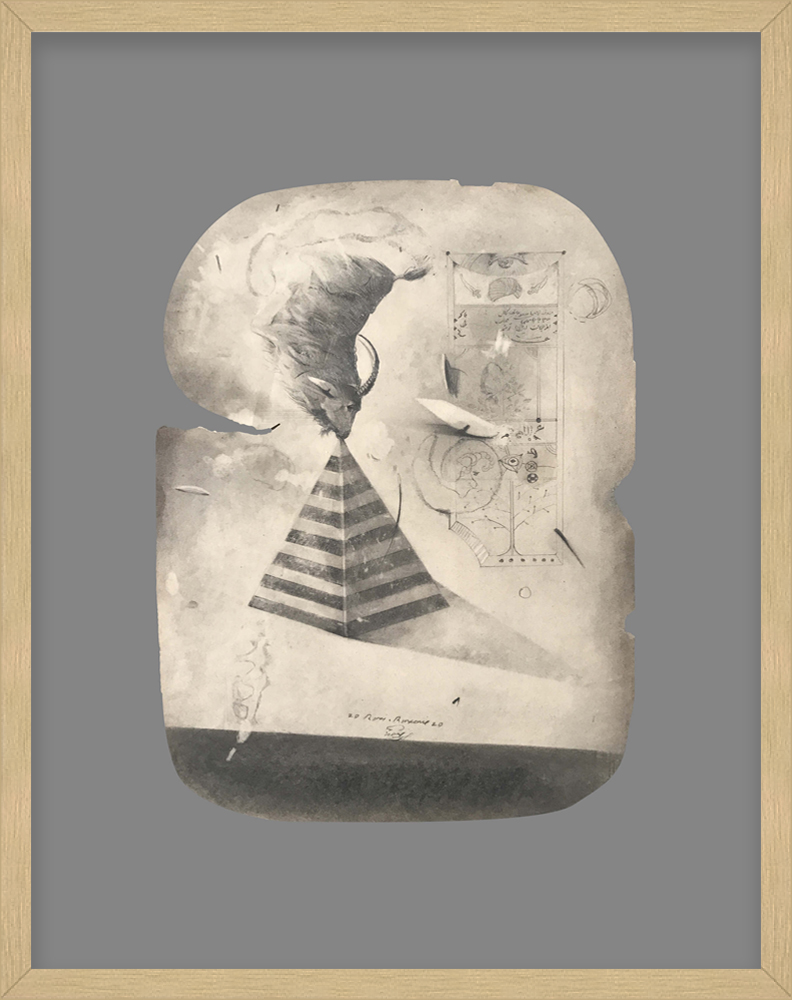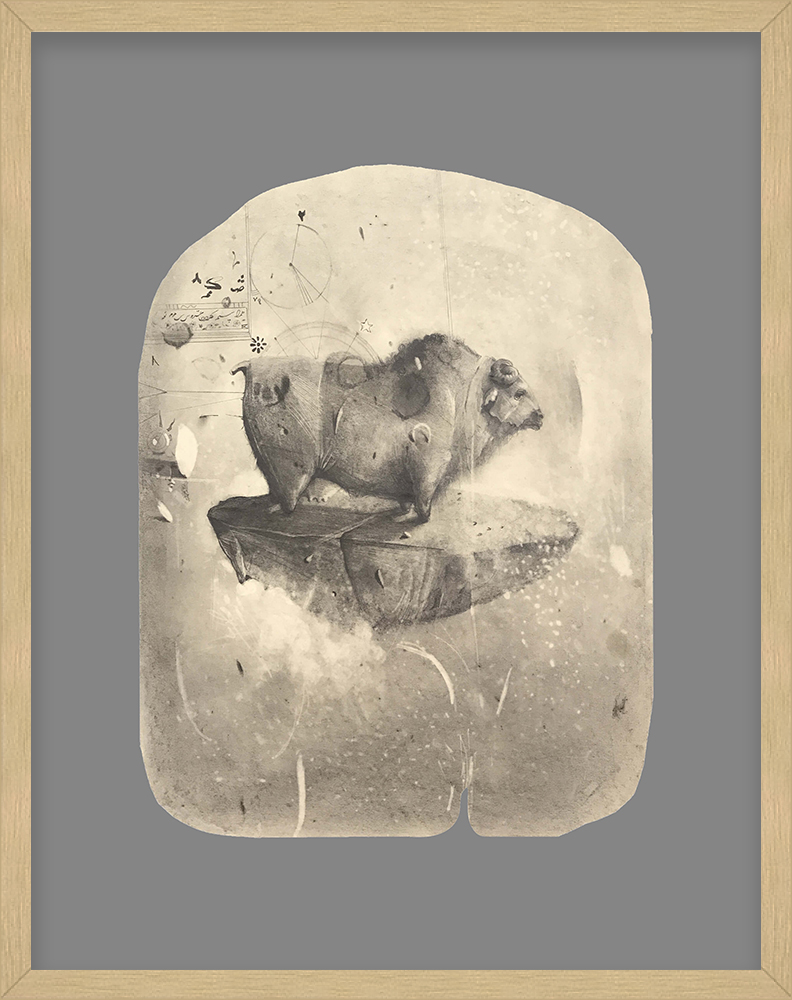The Iranian artist Razi Razavi establishes a dialogue with the audience through symbols by following the traces of the past. He seeks for the conscious and transformation passed down from generation to generation. The mutant figures depicted by the artist in his artworks build a bridge between the past and the future. We had a short conversation with the artist who settled in Istanbul from Tehran, on his art practice, and the striking differences between the two cultures.
Razi Razavi completed his B.A. degree at Nabi Akram University, Graphic Design Department, and his M.A. degree at Tehran Azad University, Painting Department.
When we think of the titles of your artworks and consider the techniques you use, they do all refer to history, creation, and beliefs. Can you briefly explain your production process?
Yes, history is both a special and important subject for me. In history, people who have lived before hold their rituals and experiences in their minds, they collect them and pass them on to the next generation. As an artist, I focus mainly on history. I compare my researches, my findings, and design my works in accordance with giving them new meanings as I want to. On the other hand, the questions such as; “Where did we come from? Where are we going? For what purpose were we born?” are outsets of my production process. In order to understand life, I analyze everything around me with great sensitivity. And while doing this, I nourish myself from history, from the past. Especially, by focusing on the concept of “mutation” I investigate what kind of a transformation has been occurred from the past to the present and what path has been followed so far. How did God create us?, What kind of a future did our ancestors have built for us? How did mammoths evolve? How did humans evolve both spiritually and physically over time, and how does this reflect on us today? Nowadays, we can read many academic research papers on these subjects. The genes that are passed down from generation to generation are actually proof that we are alone and the only one. We are people to be examined with history and today we are constructing the future generations.
The images you create in your works are depicted with some symbols. What is the relationship between the symbols and the figures?
By using symbols and signs, I can say what I want to say in a much deeper and much sensual way. Of course, my works do not only consist of symbols… However, I use them as tools. While doing this, I make research on the symbols of various cultures and examine their meanings. Then, I pass all the data I find filtering through my borders and reflect them on my works. I have worked on symbols for years. I learned how to read the traces hidden behind symbols, how to make, create meaning, and how to read them in detail. Symbols have been leading us for centuries. I also use symbols in my designs that have the meanings I have loaded. I create symbols with new meanings by combining and gathering different symbols, and the meanings of all are different.

There are two types of forms of lines throughout my works. Some are depicted with more realistic and figurative lines while some have more abstract attitudes. Sometimes, calligraphy also accompanies my drawings. When examined, the ones which have realistic style do represent the materialism world, and the abstract depictions do represent spirituality. I work quite hard before drawing every single line of my paintings. I read a lot, I spend a lot of time on the structure of my designs, and in fact, I finish sixty percent before I start. The remaining forty percent of my artistic progress precisely in line with the plan that I designed in advance.
As an Iranian artist living in Istanbul, does living here affect your artistic production? How does it affect?
Of course, living in a different geography with the variations such as; food, drink, clothing, culture, everything all affect my artistic production. If I went anywhere else from here, the influences would still be precise. I can say that living in Istanbul brought me a more liberal approach. They can ban even the smallest things in Iran. Unfortunately, as an example, I cannot share some of my drawings with the audience because they include erotic and figurative forms. Likewise, art galleries would not want to exhibit these works because it is forbidden to depict erotic and figurative. I can produce my works in Iran, but I cannot exhibit them… And it is not very motivating for an artist to produce works that you cannot show to anyone. It feels as if you are trapped. Here in Istanbul, I pursue my artistic production as I want. And I think this broadens my hand and my mind.
Considering the medium you use throughout your artwork, you usually work on paper. Do you have works that you produced by using different materials or techniques? And, are there any projects you plan to produce soon?
I know and love working on paper very well. The paper is a material that is perfect and suitable for my art practice. Its thinness, its ability to be cut, tear, and precise are in line with my philosophy. Likewise, it is very significant for me to be able to show the sensitivity of the pen on it.
Of course, I also produce works using different techniques. I have worked on cardboard, I also have oil paintings on canvas and cardboard. Sometimes I also sculpt and I love illustration 🙂

How would you compare the art scene in Iran with the art scene in Turkey?
While the heart of the art scene in Turkey beats in Istanbul, in Iran it beats in Tehran. So Istanbul’s art environment is more active and contentious than other provinces in Turkey, it is quite the same way in Iran. Galleries in Tehran do work very professionally. The fact that Iran is an Islamic state, the existence of a dictatorial regime affects the artists and the works produced by the artists. For this reason, I do not find it very correct to compare the two countries as they do not share equal opportunities. There are many more international access and opportunities are ensured for the artists living in Turkey. Here, there are various possibilities, the multiplicity of materials. The opportunities for Iranian artists to get involved in the international arena are less because of internet restrictions. Also, working in a limited environment in Iran affects the productivity of the artists. They keep on producing their artworks secretly and in the end quite original and utterly different works do emerge. There are very successful artists in both countries, there are also prestigious and decent art galleries. I think, in the future, artists and art galleries from these two countries which share similar cultures, histories, and religion, will work much more in touch with each other and have a more efficient cultural exchange.
How did you get acquainted with art50.net? What are your thoughts and expectations about taking part in one of Turkey’s leading platform for art?
I met art50.net through my friend from college, Hemad Javadzade, one of the art50.net artists. We came together at the opening of the “All In One” exhibition organized by art50.net. After some time, before the pandemic, I had the opportunity to show my work. This is how our professional relationship has been initiated.
It is very valuable for me to be here, on this art platform, and to be able to share my work with the audience. Thanks to being an artist of one of Turkey’s leading online art platforms I increase my visibility through and I think we will realize fruitful projects together.
If you were given a huge budget and you could only buy one artwork with that budget, which piece would you buy?
A tough question because there would be so many works that I would buy. I can’t even guess how much it is worth today, but the most I’d like to buy would be Francis Goya’s painting of “May 3, 1808”.
Click for the artist page.
Interview: Sena Arcak Bağcılar

 Türkçe
Türkçe